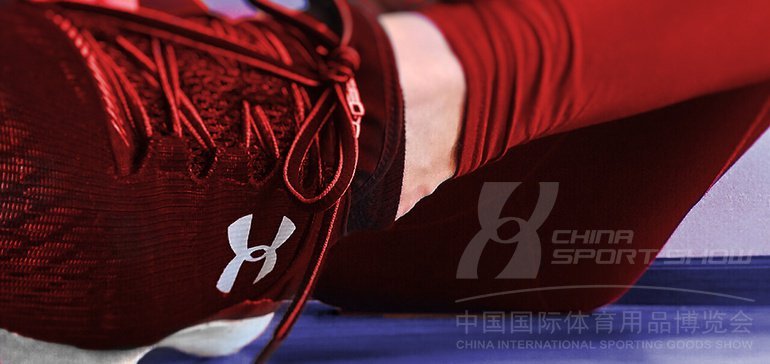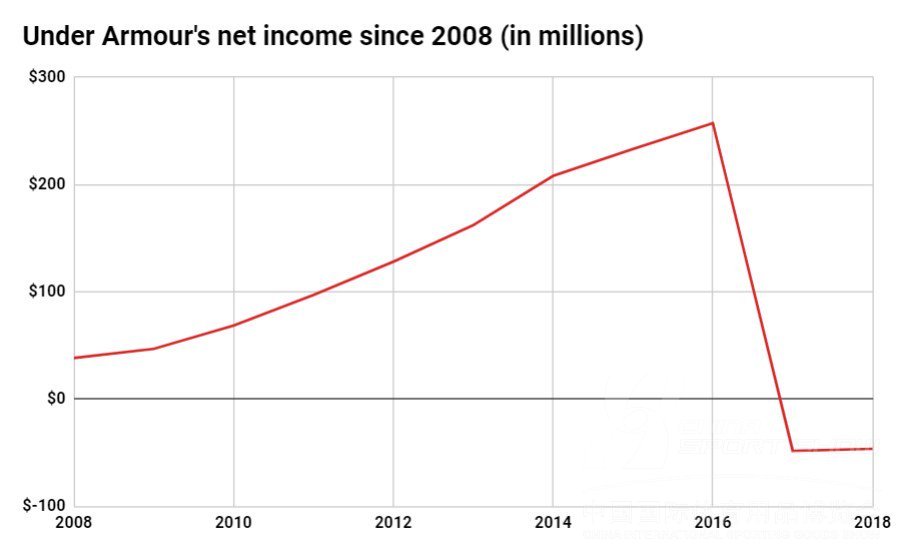Industry Trends
Is Under Armour's focus on performance wear losing it the game?
Source:China Sport ShowRelease time:18-Sep-2019Clicks:
While the rest of the industry is focused on athleisure as a lifestyle, Under Armour has reaffirmed its dedication to performance wear.

This story is part of a series. Find the rest here.
Under Armour remains a retail powerhouse in the athletics space, but challenges have cropped up on all sides.
Once the number two U.S. athletics retailer, the brand was knocked down by Adidas in 2016, which still holds the number two spot (behind Nike), according to Euromonitor International. It's also midway through a three-year turnaround plan geared at positioning the brand better for growth.
While net revenue has been on the rise at the company, albeit at a slower rate in recent years, net income dropped off in 2017, falling from a profit of $257 million in 2016 to a net loss of $48.3 million the next year. That was due to a one-time charge related to the U.S. Tax Act, and the impact of the brand's restructuring plan, according to a press release at the time.
By the end of fiscal 2018, Under Armour made $5.19 billion in net revenue, but had a net loss of $46.3 million. Nike, by contrast, made $39.1 billion in net revenue in 2018, with net income of $4 billion, an increase of 108%.

The drop-off was due to a one-time charge related to the U.S. Tax Act, and the impact of the brand's restructuring plan, according to a press release at the time. | Credit: Cara Salpini for Retail Dive
Under Armour is not trending
One of the problems facing Under Armour first manifested when women started wearing leggings and sports bras as part of their everyday attire. In other words: athleisure.
While the rest of the industry focused on athleisure as a lifestyle (read: Lululemon's new self-care line), Under Armour reaffirmed its dedication to performance wear — apparel that is meant for the gym or participation in sports. At the end of 2018, CEO Kevin Plank outlined plans to "double down on performance," citing it as a differentiator despite the fact that it "may be perceived as a weakness" to others.
"That's what gives us our reason for being … that premium performance positioning," he said at the time. But that's also what's making it hard for Under Armour to thrive right now.
"They're kind of just off-trend," Susan Anderson, a senior equity research analyst for B. Riley FBR, told Retail Dive in an interview. "They're very performance-focused right now, which is great if you want to go buy performance wear. But, the consumer, the whole streetwear trend, more fashion-infused athleticwear, athleisure, the retro '90s — which Under Armour doesn't really have any retro '90s — that's a problem. All of those things are really just not playing in their favor."
Anderson also pointed to Under Armour as a more male-oriented brand, with less styling that appeals to women trying to wear athletic clothing in casual situations.
"We've done a lot of work with focus groups and hosted try-on events to better understand how she shops for performance apparel and the language she uses to describe performance."
Morgan Goerke
Vice President and General Manager of Women's Training and Girls at Under Armour
According to Morgan Goerke, vice president and general manager of women's training and girls at Under Armour, the brand is making serious efforts to better cater to female customers.
"We've done a lot of work with focus groups and hosted try-on events to better understand how she shops for performance apparel and the language she uses to describe performance. As a result, we've taken steps to better address her needs," Goerke wrote in an email to Retail Dive, citing tests for a new bra fixture and service model.
She noted that, for the most part, the brand's strategy for men's and women's is not different, but there are some key areas the company has identified where female customers need a different approach.
"What she needs in a bra, design lines that flatter and support, language that better suits her, showing up in places she is, etc.," Goerke said. "For example, we've been working behind the scenes on updating our fit communication to use relatable and understandable language specifically for her — translating the technical language into conversational language that tells her what our products actually do for you."
According to Goerke, a "co-gender approach" was not working for some of those instances.
It's not just Under Armour that's changing its strategy. The athletics market on the whole is more male-oriented, and other retailers in the space have faced similar issues. Reebok, for one, changed its digital strategy in part because, as a company executive put it, the website was "hyper masculine" and "angry."
"It's not like everybody who's making performance apparel is in trouble."
Matt Powell
Vice President and Senior Industry Adviser of Sports for The NPD Group
In addition to limiting their own opportunity for sales, the trouble for brands creating a masculine atmosphere is that women have other options.
"There are so many other choices out there that are much more appealing," Anderson said in reference to Under Armour's women's business. "Women's is just much more competitive too, and trendy. With Lulu out there — and obviously, they have a pretty strong foothold in that market — and then you have Athleta, and they're both more kind of fashionable athleisure-based, I think that makes it harder for Under Armour to break in. But then also particularly when they don't have more of that athleisure look that she's looking for."
Neither is Under Armour cashing in on the streetwear trends that Adidas and Puma have tapped into. Staying trendy has also become more difficult as supply chains have become speedier, according to Greg Portell, lead partner of global consumer industries and retail practice at A.T. Kearney. What once took a year from concept to shelf now takes a number of weeks, making retailers more vulnerable to trend misses.
"You don't have any backup," Portell said in an interview. "So when you miss a trend, you missed the trend. You can't catch up. You just have to kind of wait until the next trend."
That's not to say that being an athletics retailer selling performance wear is a bad thing. In fact, some players in the space, including Brooks Running, are actually doing well, according to Matt Powell, vice president and senior industry adviser of sports for The NPD Group.
"It's not like everybody who's making performance apparel is in trouble. There are some brands that are thriving," Powell said, noting, however, that "the real growth in the industry is coming from athleisure."
Common sense
Since athleisure is currently a major trend in the women's space, the fact that Under Armour isn't providing that means women may not think of Under Armour as a go-to destination for athleticwear.
Goerke, however, says the brand is just thinking about athleisure differently.
"Rather than thinking about athleisure solely through the lens of style and versatility, we are building products that solve problems for athletes for both active moments and for recovery moments," she said. "We know athletes are taking a more holistic view of performance and they want to look good doing it. There is no world where performance technology cannot be used in stylish apparel and shoes, which is what we aim for in each of our pieces."
Like Nike, Under Armour has laid out initiatives in the past focused on women, but they haven't played out as well as rivals efforts have, Anderson said. That might mean that, at least for the moment, Under Armour is in a stage of regrouping when it comes to the women's segment.
The role of influencers also shouldn't be ignored. Under Armour claims Steph Curry and Dwayne "The Rock" Johnson for its men's business, and Misty Copeland and Lindsey Vonn, an Olympic skier, on the women's side. It's an impressive list of celebrities, and the brand took advantage of Misty Copeland for several ads between 2014 and 2016, but the last one focused around her story seems to be from July of 2017.
Lindsey Vonn, too, was highlighted as a brand ambassador for Under Armour during the last Olympics, with her last big spot coming in February of 2018. She has since been wrapped into the brand's Project Rock campaign as its first "ambassador." According to Goerke, that's because of a close relationship between the two, and Vonn's status as Under Armour's longest standing athlete.
"It's about being an athlete, focused on getting better, no matter the obstacles," Goerke said of the Project Rock campaign, "and Lindsey personifies that ethos and will be a key voice to continue telling that story."
While some of that may hint at a change in strategy, the usefulness of influencers also varies with the news of the day, and what's top-of-mind for consumers, according to Portell.
"Think about Lindsey Vonn: She's retired, so that has obviously changed the way that they can deploy her," he said in an interview, contrasting that with Nike's sponsorship of the U.S. Women's National Soccer Team. "The U.S. Women's National Team is going to step into those roles of relevance. So it's less an influencer role, and it's more a role of relevance, and you're going to see that take off."
With the U.S. Women's National Team comes deeply debated questions of equal pay for female athletes, which Nike seemed to gently touch on in its ad after the 2019 FIFA Women's World Cup. How athletics retailers, including Under Armour, handle those social issues in their marketing and in action, could impact how well they do with female shoppers, who are "more focused on issue compatibility," Portell said.
"I don't need to have women in corporate positions to know expensing strip club visits is bad."
Greg Portell
Lead Partner of Global Consumer Industries and Retail Practice at A.T. Kearney
As far as issue compatibility goes, the year ahead could hardly be worse than the past couple in terms of corporate culture scandals, and the mismatch between brand marketing and reality. Nearly every prominent athletics brand has come under fire for some form of discrimination or poor company practices, Under Armour included.
A former executive filed a lawsuit this summer against the retailer alleging she was fired "in retaliation for her reporting of inappropriate workplace conduct," according to court documents. The filing also alleged the retailer had a "male dominated culture and tolerance for a sexually hostile work environment."
The lawsuit cited a corporate culture scandal last November over the marketing department's spending, which allowed executives to charge adult entertainment and gambling to their corporate cards. Executives that left as a result included the brand's senior vice president of global sports marketing and senior director of sports marketing. (Added to the executive shuffling was the unrelated departure of the head of its North American division in April, a region in which it's underperformed in the past.)
While Under Armour hired a new global sports marketing exec to replace one of the executives in June, the impact of new executives will likely take a while to show in the retailer's results, and in its perception with consumers.
Reports of culture problems at athletics retailers have in general been chalked up to a boys club culture that pervades athletics, and a lack of women in management positions. But some challenges at the corporate level are more a matter of common sense than one or two bad apples in the executive team, Portell said.
"To go back to the Under Armour situation: I don't need to have women in corporate positions to know expensing strip club visits is bad."
Follow Cara Salpini on Twitter
Article From:RETAIL DIVE
Article From:RETAIL DIVE
©2008-2023 CHINA SPORT SHOW, All Rights Reserved(京ICP备05083596号-2)



